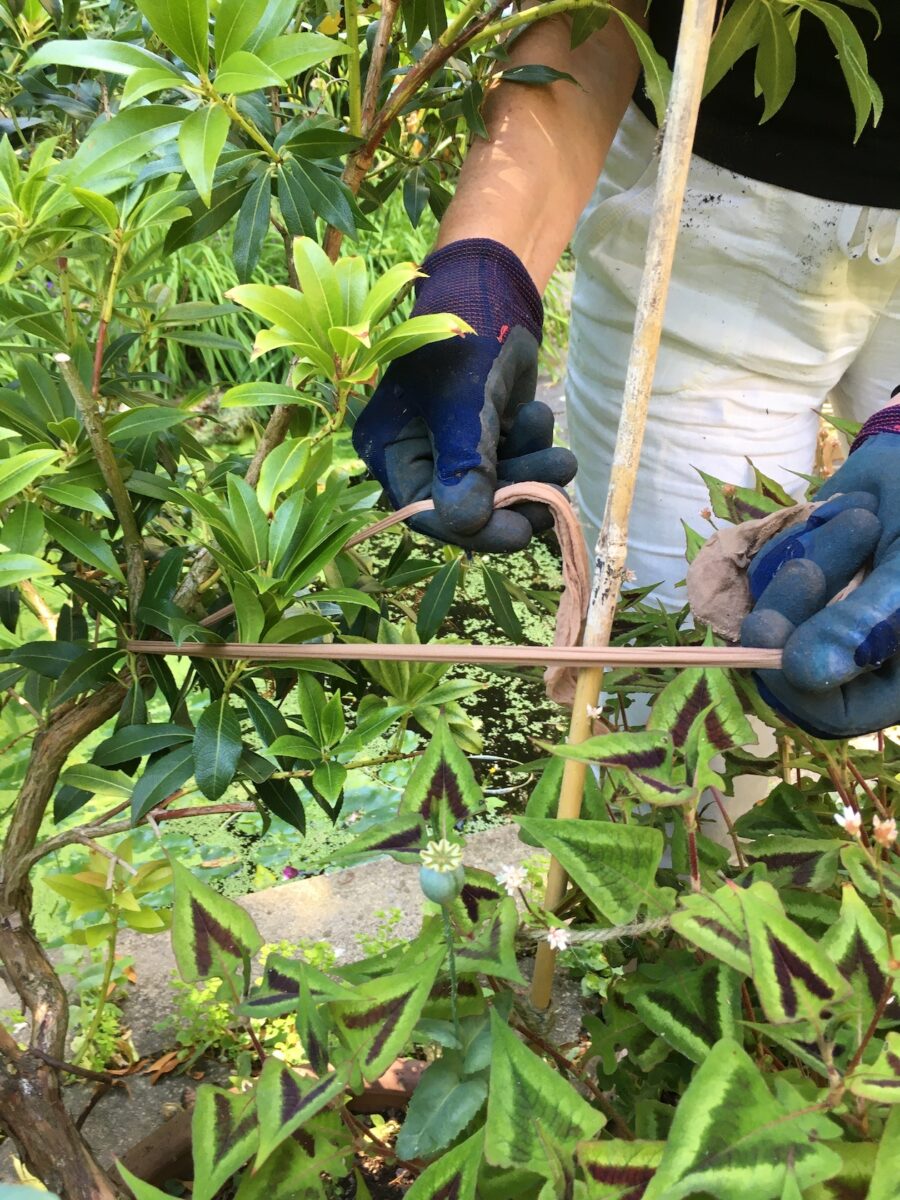
All our water butts have been filled to the brim in the last few days of downpours – relieved about that, at least! The garden is bursting with colour and growth, and a daily wander around is essential – deadheading this, tying in that….but there are some specific jobs to be done as well, like potting on chillies, cutting down oriental poppies and checking for potato blight…………
Chillies and peppers
The chillies and peppers in the greenhouse are growing strongly now. Having sown the seed in January, I feel I have been living with them for quite a long time already!
Apparently, to get the hottest chilli flavours you have to treat them mean – on the dry side, no feeding, even break the stems and shoots a bit… Not something I’m planning for, though – never seen the value of setting my mouth on fire, myself! 🥵🔥

I WILL be doing a weekly check to see if the roots have reached the bottom of their pots though, and moving them to a slightly larger pot if they have. I’ve made a short video of this potting-on process – -click on the link at the bottom. I have also started giving them a weekly tomato feed now that they have started flowering.
Keeping the hollyhocks happy
I might have mentioned before (!) that my favourite style of gardening is a soft ‘cottage’ or country-garden look, with lots of quite old-fashioned plants mixing and mingling. Not too tidy or ‘up-itself’, and a haven for birds, small mammals and insects of all kinds. One of the quintessential plants for such a garden is Althea – the hollyhock. Their lovely spikes of flower last much longer than the early summer delphiniums, and provide much-needed verticals among a sea of softer, wavier planting.

But they’re not as easy as you might think. They will self-seed in spots where they’re happy, but that might well be in the wrong place as far as you are concerned, and they hate being moved around. If you do need to move them, dig up the long tap-root very carefully, and establish it in a pot first before re-planting into the correct place in the garden.
If you’re growing them from seed yourself (either collected at the end of the summer or from a bought packet), don’t sow them deeply or keep them very moist, and don’t ever touch the stems of seedlings when you are pricking them out …..see what I mean? Tricky!

Once you’ve got these beauties happy and flowering well, there is one more problem you may have to deal with, and that is their propensity to suffer from rust – the leaves get pustules on their lower surface, turn yellow and eventually fall off. Like many people, I never use chemical fungicides in the garden these days, so I usually just pick off any affected leaves as soon as I see the tell-tale signs. This slows the spread of the rust, and really doesn’t affect the flowering much (never put affected leaves on the compost heap, by the way).

Chives contain sulphur which is a natural fungicide and I’ve read that you can make a sort of tea from chive leaves rotted in water which can help combat rust problems. This is exactly the time to cut tired-looking chive patches to the ground (they will regrow delicious fresh new shoots within a couple of weeks), so I’m going to try making a tea with the prunings…………
Gardening shorts
- My husband was throwing out old holey socks this morning – bloomin’ uncomfortable on your feet, but old socks cut up into strips make fantastic soft ties for plants that need support from canes or trellis like tomatoes, climbers or raspberries. And old tights are an excellent way of making do if you haven’t got bespoke tree-ties.

- Don’t oriental poppies look a total mess after they have finished flowering! The good thing is that they don’t need any of that tatty top growth at all any more, so you can cut it all away, and the plant will produce a few small leaves in about 3 weeks (which is handy because it reminds you where it’s planted). Laura shows you how to do this in a little video, using the great new herbaceous sickle that we now have in our online shop. The link is at the bottom.
- Succulents are leaping up the popularity scale now that we are all aware of the effects of climate change. This is a good time to split the offsets from the main plant to make new houseleeks (Sempervivum), or the closely related but tender Echeveria.
Turn the pot upside-down, and tap the rim to drop the plant out into your other hand. Pull apart or snip off the little rosettes round the side, making sure that each has a short stem or some roots. Plant the offsets into pots of gritty compost then leave them a couple of days for the cut stems to callus over a little before you water them in.

- Watch out for any telltale brown patches of blight on the potato crop. If you see any, cut down the foliage to ground level to prevent it spreading (burn this material if you can), but leave the potatoes in the soil for 2-3 weeks. The spuds won’t get any bigger after you’ve removed the top growth, but you may have saved some or all of this smaller yield. Only use the potatoes that are firm all over and look free of the disease.
Here is the link to Laura giving an admirable demonstration of our great little herbaceous sickle.
And this is the link to my little video about potting on chillies and peppers
More NB If you’re not already a subscriber and you’d like a bit more gardening chitchat from the3growbags, please type your email address here and we’ll send you a new post every Saturday morning.


4 replies on “Keep on top of the summer jobs! Grow-how tips for July”
I too have germinated Hollyhock seeds, but chose Althea Ficifolia, which is the fig-leaved Hollyhock. According to the packet, is less susceptible to rust – I’ll keep you posted! In the past I have bought the Lemon flowered Ficifolia but this year found a packet of mixed colours, so will see what happens…..
Thank you so much for writing in, Chris. I have just looked up Althea ficifolia, and it looks really, really interesting! I am definitely going to try these. There seem to be a few suppliers around, and any hollyhock that is less prone to that wretched rust has got to be worth a punt – thank you so much for the heads-up. All the best, Elaine
Hi there,
I’ve grown Hollyhock seedlings this year for the first time from seed and am awaiting the flowers with much excitement. I’ll keep you posted.
A tip for holely socks I use is…. cut the feet off then slip the leg part of them over the tops of my gardening gloves with my sleeves tucked in to prevent scratches and prickles and the sneaky odd midge bite.
I love your tips and try them out each week.
Thank you!
Hi Mandie, Elaine here. What a fantastic tip about using holey socks! Gauntlets are too cumbersome for many gardening tasks, and my arms are a mass of scratches, stings and muddy marks even though I use gloves for most jobs. I might even start chopping old socks I don’t really like any more! Good luck with the hollyhock seeds – I would love to hear how you get on. All the best and happy gardening.